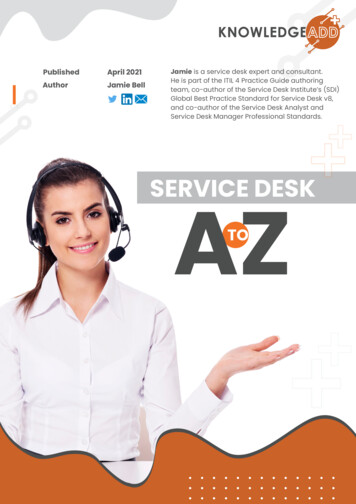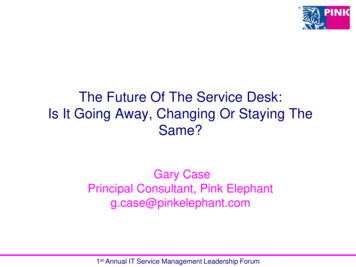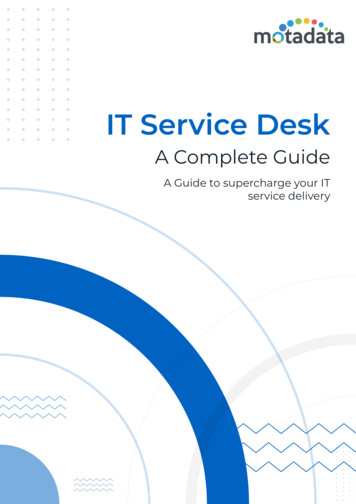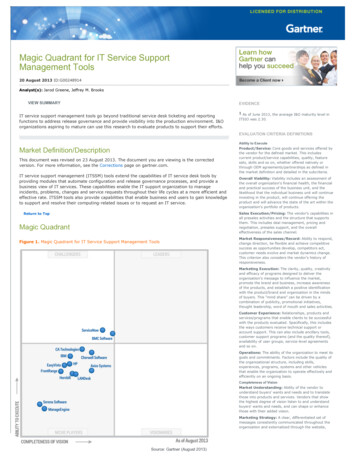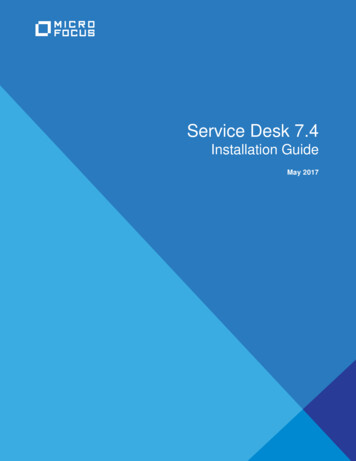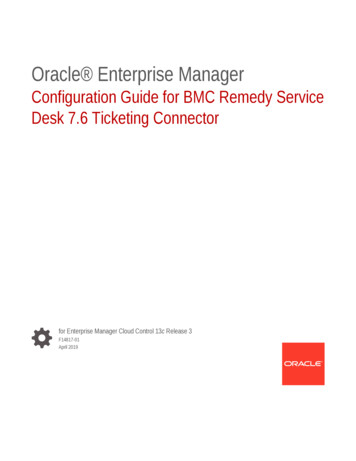
Transcription
WHITE PAPERThe Service DeskIncrease adoption and leverage ITinvestments with a well-trainedsupport function.Robert DrewniakDirector, Strategic & Advisory Services
Hayes Management WHITE PAPER: Service DeskNo Support? No Adoption.Electronic health records (EHR) are a far cry from plug and play. Therefore,implementation is not an example of “build it and they will come.” In fact, theadoption of EHRs has little to do with technology, and a lot to do with how theorganization manages the transition. There are multiple critical success factors;one of the most critical is support. Delays in response time frustrate users andpatients. They also negatively affect adoption rates. When implementing anEHR, organizations should pause to review, modify, or develop a support model,beginning with the service desk.EHR support requests are different than typical “help desk” calls. They are oftenmore related to workflow and process versus solely technical. For example, aphysician calls with questions about entering an order. The request is not merelytechnical; it is related to patient care. The EHR support staff needs to understandthe physician’s screen flows and workflow. Help desk service agents need to alsounderstand the user’s objectives and needs.Building a Help DeskThe EHR support model should follow the structure and standards set forth in theIT Infrastructure Library (ITIL). ITIL standards set the framework for an ITorganization to develop a customer-oriented mindset in a structured manner.These standards and processes allow the IT organization to focus on outcomesand reporting to and for the users. The ITIL is a set of concepts and policies formanaging information technology infrastructure, development and operations.The ITIL also includes event, incident, problem and change management. Theseelements provide the basis for developing metrics that are used in creatingservice level agreements (SLAs) with end users. SLAs set the expectations forusers and service staff.Once developed, the support plan needs to be clearly communicated to not onlyservice desk staff, but all users. The plan should explain and illustrate thefollowing processes: The process used by technical support staff to provide assistanceThe process used by users to ask for assistanceThe process used by technical support staff for:o Event managemento Incident managemento Problem managemento Change managemento Service level agreementsGraphics are a great way to convey information. They should be easily at handfor users to remind themselves of the process. A graphic can serve as acontinuous training tool – less likely to be shelved and more likely to be pushpinned in a cube wall – and makes the help desk function more efficient andeffective.2
Hayes Management WHITE PAPER: Service DeskThe following graphic representation is an example of a support model. The topdescribes the call flow, handling and agent processes; the bottom describes thefoundation of the support process.Figure 1This diagram describes the flow of incidents from problems to resolution andincorporates change management/continuous improvement: Change requestService requestManagement metricsOpportunities forstandardizationChange Problem managementmetrics Understanding oforganizationalprocesses andpotential patterns andproblems Service & changemanagement requestscan be identified aspart of the resolution ofa problemIncident Identification andresolutions of incidents Management metrics End user trainingopportunities Service desk/ supporttraining opportunities Service request can beidentified as part of theresolution of anincidentProblemFigure 23
Hayes Management WHITE PAPER: Service DeskTop Ten ConsiderationsWhen structuring the service desk for EHR support, the following elements areimportant to consider:1. Hiring. You need to hire the right people for good EHR support. Importantqualities to consider are: Good communication skills (verbal and listening)Knowledge of operational/clinical environmentsService-oriented (prior work experience)Technically savvyYou will undoubtedly need more people directly after go-live than you will ayear down the road. Therefore, you may want to consider hiring interimresources trained on your EHR system for the first few months, and thenscale down to internal staff.2. Training. Thorough and thoughtful training is key to a successful servicedesk support approach. The following are some suggestions for preparing awell-trained EHR service desk support team: Work with the training team to use existing training material and, whenneeded, create specific training material for the service desk agents. Integrate trainers and EHR project team members into the supportdesk on a rotating basis to help with knowledge transfer. Rotate support desk agents through clinics and acute careenvironments during orientation and periodically thereafter to buildknowledge and most importantly, relationships with end users. Post-training reinforcement: Clearly diagram the call handling processincluding a description of roles and responsibilities at each level ofsupport (as previously illustrated). For example, Level “0” would belocal support from a super user, co-worker or manager. Level “1”would be the service/help desk, etc.3. Multiple modalities for accessing support. The service desk should beavailable 7 days per week, 24 hours a day, 365 days per year. There shouldbe options for obtaining help that correlate to urgency and user preference.Create self-help websites, training websites, self-help password reset, etc.These tools provide options for users, which decrease service desk callvolume. In addition, create a voicemail box and email box for users to “drop”non-urgent questions that can be answered within two to four hours.4. Service Level Agreement metrics. All service agents should be aware ofthe terms in the SLAs and evaluated on the metrics. Therefore, ensure thatall agents are clear about the requirements regarding calls abandoned, speedto answer, service levels, first call resolution and other metrics used by yourorganization.4
Hayes Management WHITE PAPER: Service Desk5. Super users. Clearly identify and make clear the role of the super user.Super users are critical to adoption, as they provide training quickly at theright time and the right place.6. Knowledge Management System (KMS). Create scripts that agents canfollow to ask appropriate and meaningful questions. Identify workflowscenarios that the agents may use both in training and to support users postgo-live. Tools such as the KMS, BMS Remedy, SalesForce, PeopleSoft, andothers can be used to provide the process to track calls and callers, create acall record history, and provide scripts/reference material for agents.7. Standardized processes. Implement standard processes for escalation andthe event management. If done properly, these processes will support thereporting required for leadership and users.8. Disaster recovery/business continuity plan. All service desks should havea continuity plan developed to ensure that failover can be performed in arapid manner. The DRP/BCP should be aligned with your organization’s ITplan.9. Reporting. Ensure that appropriate daily, weekly, monthly and yearly reportsare created and distributed to designated recipients. Check with leadershipon a consistent basis to ensure that the appropriate people receive the rightreports. The reports should reflect the processes stated in item #6 and theperformance against SLA metrics, i.e. service desk statistics, wait times, callvolume, call types, incident/problem management, etc.10. Communication planning. A well-documented communication processshould be in place that lets users know about any changes (i.e., newreleases, time schedules, etc.), reminds them about procedures andeducates them on related support topics.The ideal support model is based on a strategic partnership between businessowners and IT. A feedback loop will allow continuous improvement andresponsive adaptation to changing user needs. EHR support should never be anadd-on or afterthought, but an integral part of pre-implementation planning. Hiringthe right people, integrating support staff with functional areas, etc. will make ahuge difference in adoption rates and post go-live user satisfaction.About HayesHayes works with healthcare organizations to increase net revenue and improvepatient experience. Hayes is ranked Top Professional Services Firm by KLAS,and has received multiple Best in KLAS awards since 2005. Hayes is also rankedin Healthcare Informatics’ Top 100 and Inc. 5000.Hayes consultants are subject-matter experts in IT strategic planning, revenuecycle improvement, system implementation, interoperability and business andclinical operational efficiency. Hayes also offers software solutions to improveefficiency and productivity. To learn more about Hayes’ services, visitwww.HayesManagement.com or call us at 617-559-0404.* Source: www.KLASresearch.com. 2010 Top 20 Best in KLAS Awards: Software & ProfessionalServices.5
Thorough and thoughtful training is key to a successful service desk support approach. The following are some suggestions for preparing a well-trained EHR service desk support team: Work with the training team to use existing training material and, when needed, create specific training material for the service desk agents.


